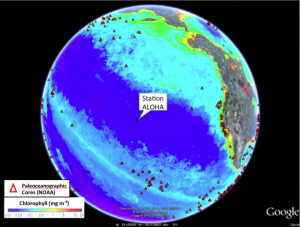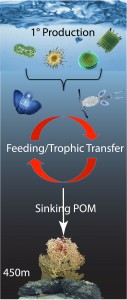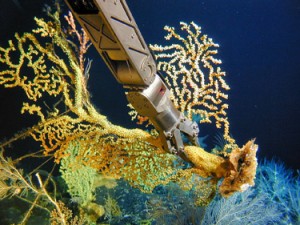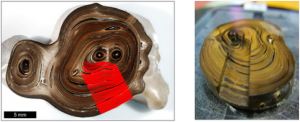
The North Pacific Subtropical Gyre (NPSG), shown here, is the largest continuous ecosystem on earth, and a critical regulator of global CO2 and biogeochemical balance. According to recent satellite observations, the NPSG is expanding at a rate of 1-4% per year. It is challenging to reconstruct past ocean conditions using traditional sediment cores (red triangles) in the NPSG due to extremly low sedimentation rates (0.6 cm/kya). As such, the entire Holocene record is represented in
The central subtropical gyres cover approximately 40% of the ocean’s surface, with the North Pacific Subtropical Gyre (20 million km2) making up the largest continuous ecosystem in the world. Though once considered vast oceanic deserts, these oligotrophic systems are increasingly understood as critical components of global ocean productivity, biogeochemical balance, and carbon sequestration. Numerous lines of evidence suggest that shifts in open ocean food web structure are intimately connected to oceanographic conditions. In the face of increasing climate change, it becomes imperative to understand recent changes at the base of the subtropical gyre food webs in the context of longer-term trends. However, our understanding of how subtropical gyre plankton communities have shifted on centennial time scales has been limited by available methods and paleoarchives of sufficient length and resolution.

Deep-sea corals act as “living sediment traps,” faithfully recording an isotopic and biochemical signal of recently exported production to the mesopelagic ocean interior. (Composite by McMahon, individual images form wikimedia)
This project is part of a multi-institution effort to understand past changes in open ocean ecosystem food web structure and biogeochemical cycling using deep-sea proteinaceous corals as biogenic archives. Deep-sea corals act as “living sediment traps,” preserving an archival record of export production over millennial time scales at a resolution nearly comparable to modern observations. As part of this project, I am developing an amino acid stable isotope fingerprinting approach to reconstruct the phylogenetic identity and timing of shifts in phytoplankton community composition supporting export production to the mesopelagic ocean interior over the past several thousand years. By understanding how and when plankton assemblages at the base of open ocean food webs have changed in the past, we can better understand future changes in food web architecture, biogeochemical cycling, and carbon sequestration in the modern era of rapid climate change.
This project complements and expands on recent work by my colleague Dr. Owen Sherwood, who examined past changes in NPSG biogeochemical cycling using a compound-specific stable isotope approach with the same deep-sea corals.
Collaborators:
Dr. Mathew McCarthy: University of California, Santa Cruz; Dr. Thomas Guilderson: Lawrence Livermore National Laboratory; Dr. Owen Sherwood: University of Colorado, Boulder; Dr. Thomas Larsen: Christian-Albrechts-Universität zu Kiel

Hawai’ian gold coral colony sampled
iat 450m depth near Makapuu, Hawai’i. Photo credit: NOAA Hawaiian Undersea Research Laboratory, DSRV
Pisces Pilots & Engineers, 2004.
